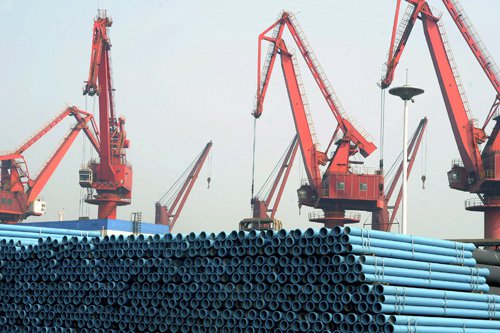|
 |
|
PULLING AHEAD: China-made cast steel pipes lie at a port in Lianyungang, east China's Jiangsu Province, waiting to be shipped, on May 1 (WANG CHUN) |
China is a major power in the world. That's undebatable. But a report from the World Bank suggests the country's economic size may be bigger than previously thought, maybe even to the point of soon surpassing the United States. The latter has been the world's largest economy since 1872, when it overtook the United Kingdom, and has held the crown for more than 140 years.
A World Bank report says that based on 2011 prices, the purchasing power of China's currency, the yuan, was much stronger than what was reflected by exchange rates. By that measure, China's economy was 87 percent the size of the United States in 2011.
Soon after the data were released on April 29, Western media anxiously started the process of calculation and speculation. With the International Monetary Fund (IMF) having expected that China's economy would grow 24 percent between 2011 and 2014 while the United States is projected to expand only 7.6 percent, China is likely to overtake the United States this year, according to reports from mainstream Western media outlets.
That's far sooner than previous forecast: the OECD estimated China would become the world's largest economy as early as 2016 and the Chinese Academy of Social Sciences pegged 2020 as the year that would happen.
In sharp contrast to the excitement displayed by Western media, Chinese media remained calm and stoical. Their attitude was that the time for celebration had not yet come, as they reflected on the flaws in the methodology of the newly released data. Traditional wisdom dictates that the sheer size of an economy is not the only important measure of how well a nation is doing economically or how powerful it is. In terms of standard of living for the average Chinese, the country has a long way to go.
A questionable methodology
When comparing different countries' GDP, economists usually use exchange rate as a converter. By this measure, China's $8.2 trillion GDP in 2012 was only 51 percent of the size of America's $16.2 trillion GDP. It will be a long time before China takes away America's economic crown.
However, as has been pointed out by some economists, exchange rate-based comparison between different economies can be misleading, because exchange rates fluctuate constantly and dollar-based GDP data don't necessarily represent a country's true economic size.
The International Comparison Program (ICP) held by the World Bank produces internationally comparable GDP based on purchasing power parities (PPPs). To calculate the PPPs, the ICP holds surveys every six years to collect price and expenditure data for the whole range of final goods and services that comprise GDP including consumer goods and services, government services and capital goods.
PPP figures by the World Bank are the most authoritative estimates of what money can buy in different countries and are used by most public and private sector organizations, such as the IMF. PPP adjusts the numbers to reflect what people in a given economy can actually afford.
PPPs are both currency converters and spatial price deflators. They are used by the ICP to make the GDPs of different countries comparable. Initially, GDPs are not comparable because they are expressed in national currencies and valued at national price levels. But, after PPPs are applied, the GDPs are converted to a common currency and are revalued at a uniform price level. As a result, differences between the GDPs reflect only differences in the volumes of final goods and services purchased, according to the World Bank.
After extensive research on the prices of goods and services, the ICP concluded that money goes further in poorer countries than it previously thought, prompting it to increase the relative size of emerging market economies.
| 